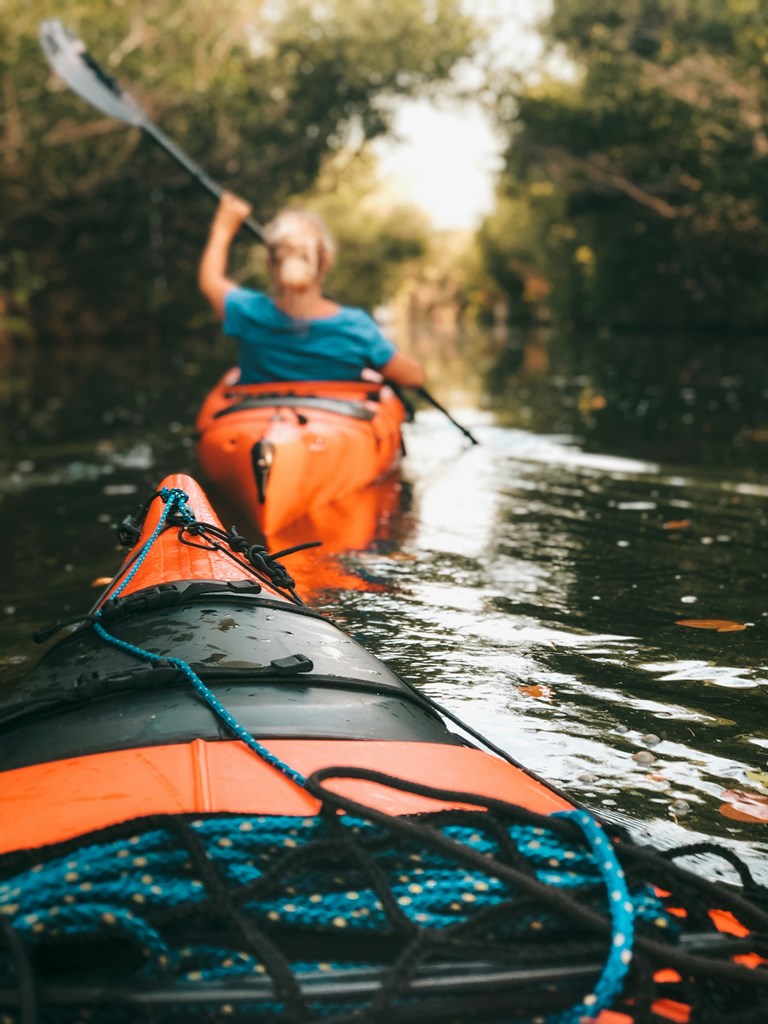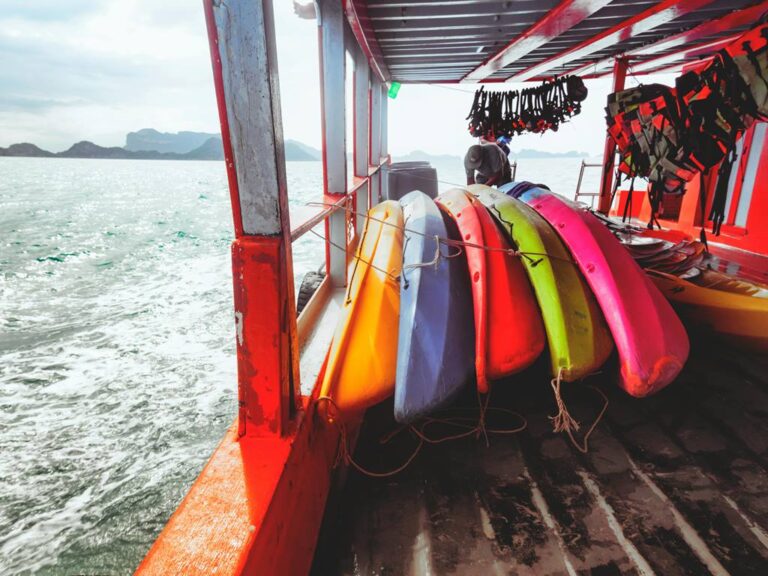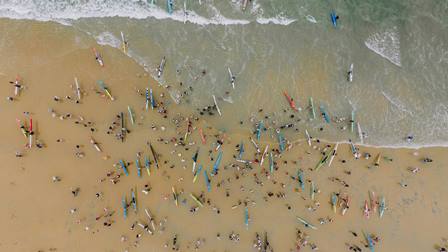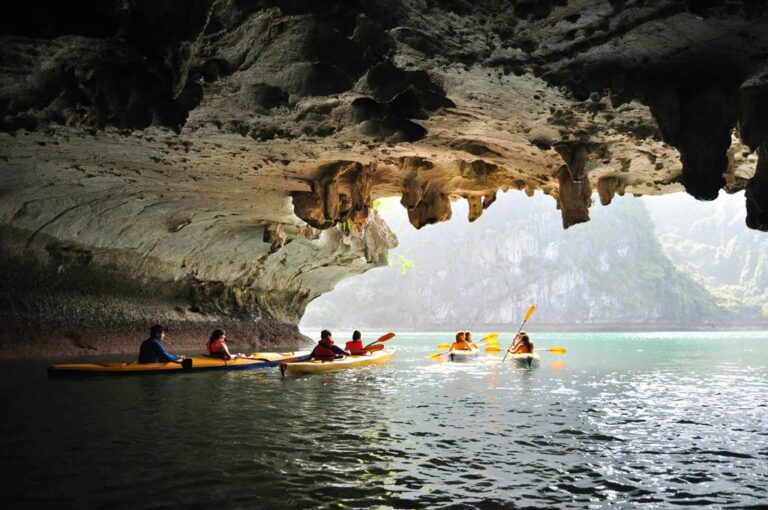
For recreational kayakers, things can get tricky when winds reach 15-20 knots (17-19 mph). At these speeds, the water gets choppy and paddling against the wind becomes a real challenge. Experienced paddlers might be able to handle stronger winds, up to 17 knots (19 mph), but for most, it’s best to stay on shore when the wind picks up significantly. Extra caution is essential for sea kayaking and kayak fishing, as you’re often in more open water. Be even more careful with winds above 8 knots (9-10 mph) in these situations.
Ever paddling along on a calm day, then suddenly feeling like you’re in a wind tunnel? Yeah, strong winds can turn a relaxing kayak trip into a battle for balance. But don’t let that stop the kayaking fun!
Here’s the key: knowing your wind limits. This way, you can decide if it’s a good day to paddle or a good day to chill on land. Keep reading to find out what wind speeds are smooth sailing and when it’s smarter to stay dry!
Table of Contents
Why Is Wind a Challenge for Kayakers?
A little wind can be a kayaker’s best friend! Imagine cruising downstream with a gentle breeze pushing you along, or getting a helpful boost upstream. It’s paddling on easy mode!
But watch out! Too much wind turns that friend into a foe. Ever tried paddling against a gale? It’s like fighting a giant fan, and let’s be honest, not much fun. Plus, strong winds whip up waves that can make your kayak feel like a rodeo bull. Not ideal for a relaxing day on the water!
Wind speed isn’t the only worry. Wind direction can be a sneaky villain too! Imagine paddling out for a relaxing day and then realizing a sneaky offshore wind is making it super tough to get back to shore. Talk about a party pooper!
Headwinds can also turn a leisurely upstream paddle into an arm-shredding battle. But hey, on the bright side, a tailwind acts like your own personal water jet, making cruising downstream a breeze (literally!).
Here’s another thing: strong winds can turn you into a popsicle in no time! Especially if you’re not dressed for the conditions. All that wind whipping up spray can leave you cold and wet, increasing your risk of hypothermia. So, before you head out, make sure you’re dressed for the windchill, not just the air temperature.
What Wind Speed is Safe for Kayaking?
Are you a kayaking newbie or a seasoned pro? Do you know the local waters like the back of your hand, or is this uncharted territory? Most importantly, how much risk are you comfortable with?
Before we dive into wind speeds, let’s talk about how this whole “wind measurement” thing works. There are three main ways:
- Beaufort Wind Scale: This fancy term, invented by a sailor named Sir Francis Beaufort way back in 1805, describes wind speed based on what it DOES to the water. It’s like a cheat sheet to understand how the wind will affect your kayaking adventure.
- Knots: This is how sailors measure wind speed at sea. Think of it like miles per hour, but for boats (one knot equals one nautical mile per hour, which is a little longer than a regular mile).
- Miles per Hour (mph): This is the classic way we measure wind speed on land. If you check the weather forecast for your kayaking trip, this is probably the unit they’ll use.
We’ll break down the wind speeds in each of these measurements next, so you’ll know exactly what to expect when you hit the water!
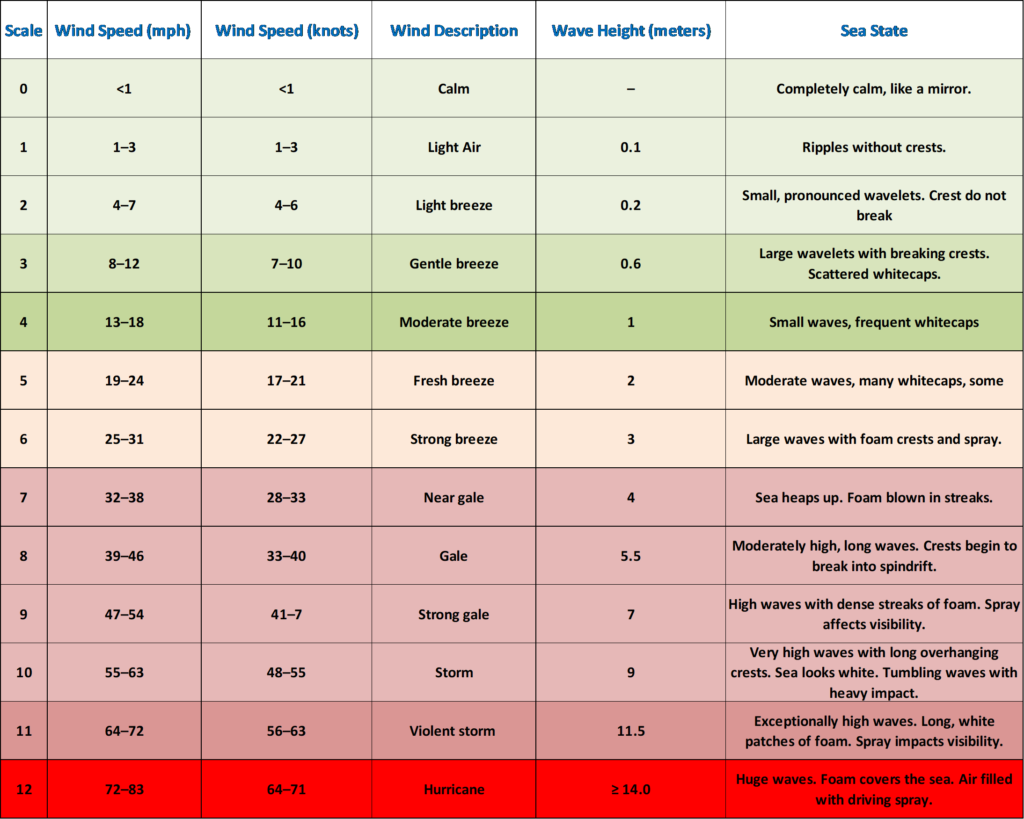
What is the Recommended Wind Speed for Safe Recreational Kayaking?
Protected paddling spots like creeks, ponds, and small rivers are a kayaker’s wind chill-out zone! The wind doesn’t have as much room to rev up, so the waves stay small and paddling feels smooth sailing. But on big lakes or oceans, that’s a different story. The wind has a much longer runway to get crazy, which means bumpier waves and a trickier paddle.
- Chill Winds (Under 10 knots, 12 mph): This is a “gentle breeze” according to the fancy Beaufort scale. Don’t let the name fool you though, paddling against it back to shore can feel anything but gentle!
- Intermediate Paddlers Only (Up to 16 knots, 18 mph): Feeling adventurous? If you’re a more experienced paddler, you might be okay with winds this strong. Even beginners can handle these conditions on super calm, sheltered water like ponds or creeks.
- Strong Wind = Experienced Paddlers Only (Above 17 knots, 19 mph): Think of these winds as your personal kayak boot camp! Only take them on if you’re a seasoned paddler looking for a challenge. Here’s the key: have an “exit plan” in case you can’t get back to where you started, and always go out with a group for safety.
Remember, recreational kayaks are built for stability, not speed. This means they’re tougher to paddle in the wind compared to touring or sea kayaks.
Sit-Inside vs Sit-On-Top for Windy Days: If you’re going out in strong winds, a sit-inside kayak might be your friend. They sit lower in the water than sit-on-tops or inflatables, making them less like a wind toy. Plus, you can use your whole body to paddle (think more power!), which helps when battling a headwind.
ALSO READ: How Safe is Kayaking?
What Wind Speed is Considered Safe for Sea Kayaking?
Big open water like the ocean is a whole different ball game for wind. Here’s why:
- Sea Kayaks for the Win: Sea kayaks are like the muscle cars of the kayaking world. They’re longer and narrower than regular kayaks, designed to handle rough conditions, including strong winds.
But wait, there’s more!
- Bigger Waves, Bigger Challenges: Even though your sea kayak is a wind-fighting machine, strong winds at sea create much bigger waves than on calmer waters like lakes or rivers.
- Ocean Oddities: The weather on the ocean can change faster than a chameleon! What starts as a gentle breeze can turn into a wild windstorm in no time.
Since things can get serious much quicker on the ocean, it’s always best to be extra cautious when sea kayaking, especially in windy conditions.
Here’s the wind speed guide for sea kayakers:
- Smooth Sailing (Up to 8 knots, 9-10 mph): These gentle breezes are your ocean paddling sweet spot!
- Think Twice Before You Go (Over 14 mph): Venturing out in stronger winds? Stick to sheltered bays and be prepared to head back to shore if the weather takes a turn for the worse.
- Stay Home, Stay Safe (Over 21 knots, 24 mph): When the wind gets this strong, the US Weather Service might even throw out a “small craft advisory warning” – basically their way of saying “Stay on land!” Big inland waters like the Great Lakes can also act like mini-oceans when it comes to wind. Treat them with respect and don’t risk a paddle in super windy conditions.
What Wind Speed is Recommended for Safe Kayak Fishing?
Wondering how much wind is too much for casting a line? Here’s the deal:
Basically, the wind speed guidelines for kayak fishing are similar to regular kayaking. But there’s one key thing to remember: most fishing kayaks sit higher in the water, sometimes with raised seats. This might be great for spotting that prize catch, but it also means strong winds can blow you around more easily. So, be extra cautious on windy days and choose a sheltered spot if the gusts start picking up!
Even the most experienced kayaker can get surprised by a wave or a gust of wind. But if you can do an Eskimo roll, you can right yourself and get back in the game in no time.
Check out this video to see how it’s done
Now, fishing kayaks loaded with gear are a different story. All that extra weight makes your kayak more tippy and harder to maneuver. So even if you’re a pro at Eskimo rolls, a capsize with a fishing kayak full of gear could be a real challenge to handle on your own. Be extra cautious on windy days, and choose a sheltered spot if the wind starts picking up.
Wind speeds can be a kayaker’s worst enemy, especially when your boat is loaded with gear. Here’s the lowdown:
- Open Water: For calm fishing on big lakes or oceans, stick to winds under 8 knots (9 mph).
- Small Waters, More Wiggle Room: On calmer ponds or rivers, you might be okay with slightly stronger winds, but be ready to head back to shore if it gets too gusty.
- Experienced Anglers Only: If you’re a pro kayaker who knows the water well, you might be comfortable with winds up to 13 knots (15 mph). But remember, all that extra fishing gear can make your kayak tipper, so be extra cautious!
How to Kayak in Windy Weather?
Don’t let a little wind rain on your kayaking parade! If the forecast is windy but you’re dying to get out on the water, here are some tips:
- Pick your paddling spot wisely: Seek out sheltered, inland waterways where there’s no chance of getting blown out to sea. Hug the shoreline and always have a plan for getting back to land quickly in case the weather worsens.
- Wind as your teacher: Instead of seeing wind as a roadblock, view it as an opportunity to hone your paddling skills! Turning challenges into learning experiences can make kayaking even more rewarding.
- Master the wind: Check out this video, for tips on paddling techniques in windy weather
What to Do If the Wind Strengthens While on the Water
You started paddling with a gentle breeze, but now the wind has picked up and things feel sketchy. Here’s what to do:
- Don’t Panic! Take a deep breath and stay calm.
- Check the Wind: Figure out how strong the wind is and which direction it’s blowing. This will help you decide the safest way back to shore.
- Change Plans: You might need to ditch your original plans and land somewhere different. It’s a pain to get your kayak from another spot, but safety comes first!
- Paddle at an Angle: If the wind is hitting you sideways and your kayak keeps turning into the wind (weathercocking), don’t fight it head-on. Instead, paddle diagonally towards a point on shore that’s slightly upwind from where you want to land. The wind will push you sideways, but eventually get you close (or right!) to your original destination.
How to Prepare for Kayaking in Windy Conditions
Weather can be a fickle friend, especially for kayakers! So, if the forecast looks like it might get windy, here are some tips to keep your paddling adventure safe and fun:
Be Weather Wise Before You Kayak!
Even on a sunny day, a quick check of the forecast can save you from a windy surprise. Here’s how to stay informed:
- Check the Forecast: It’s a kayaker’s best friend! Look for wind speed and direction predictions before you head out.
- Read the Sky: Learn to recognize signs of bad weather like dark clouds or strong winds blowing in a certain direction.
- Plan for Changes: Wind can shift throughout the day, so be flexible and adjust your plans if needed.
- Marine Forecast for Open Waters: Venturing out to sea? Check the marine forecast in addition to the regular forecast. This will give you specific details about conditions offshore.
- Windfinder.com: This website is a handy tool for kayakers, offering live weather and wind maps with wind speed and direction predictions.
By being weather-savvy, you can ensure your kayaking adventures are smooth sailing (or paddling!
Familiarize Yourself with Local Waterways
Even the most experienced kayaker can get caught off guard by wind. Here’s how to stay safe:
- Know Your Local Waters: Many kayakers get surprised by wind after paddling from a calm bay into open water. The better you know your usual paddling spots, the easier it is to judge wind risks.
- New Territory? Ask Around: Paddling somewhere new? Get local advice before launching. Talk to experienced kayakers or park rangers familiar with the area. They can share valuable insights about wind patterns and hidden hazards.
Bring Safety Equipment (and Learn How to Use It)
No matter the wind forecast, here are some essential safety items for every kayaking adventure:
- Life Jacket (PFD): This goes without saying! Always wear your PFD – it’s your best friend on the water.
- Bilge Pump or Bailer (Sit-Inside Kayaks): If you’re in a sit-inside kayak, or use scupper plugs in your sit-on-top, carry a bilge pump or bailer to remove excess water.
- Whistle: Small but mighty! A whistle takes up almost no space and is a loud, effective way to signal for help if needed.
- Tow Lines (Throw Ropes) for Groups: Planning a group paddle? Pack some tow lines (throw ropes) in case someone capsizes or gets tired.
- Waterproof Clothing: Don’t underestimate the power of staying dry! Strong winds can bring lots of spray. Waterproof clothing offers more protection than just windproof layers, keeping you warm and comfortable.
Avoid Paddling Alone
Venturing out in windy conditions? Safety always comes first, and there’s strength in numbers. Consider taking an experienced friend or two – you can keep an eye on each other, and if someone runs into trouble, there’s immediate help available.
Paddling solo? Make sure someone on land knows your plans. Share your route, estimated return time, and check in with them once you’re safely back. It’s a small step that can make a big difference if things take an unexpected turn.
Start by Paddling Upstream or Against the Wind
Paddling smart is key, especially when wind is in the forecast. Remember, going with the flow is always easier! Just like paddling upstream against a calm current is tough, paddling upstream against a headwind can be a real struggle. You might find yourself exerting a lot of energy without making much headway.
Here’s a pro tip: If you plan on paddling upstream, start your journey there. That way, if you get tired or the wind picks up later, you can easily coast back downstream with the current and wind at your back. This strategy applies to paddling into the wind as well. By starting your adventure downwind, you’ll have a much easier paddle back if the wind strengthens.
Stay Close to the Shore
Wind and currents often chill out the closer you are to shore. While venturing further out can be tempting, remember: conditions can change fast, leaving you battling to get back. Staying close to shore offers two big advantages:
- Easier Escape: If the weather takes a nasty turn, it’s much easier to bail out (get back to land) when you’re close by.
- Signaling for Help: If you find yourself in trouble, being closer to shore makes it easier to signal for help and get assistance faster.
Have an Alternative Plan
The wind can be a bit of a prankster, sometimes blowing you off course and messing with your kayaking plans. Here’s a tip to stay ahead of the game:
Before you launch, check the wind forecast for both speed and direction. Then, identify one or two safe alternative landing spots along your route. This way, if the wind decides to play a trick and push you off track, you have a backup plan and a safe place to land instead of battling back against the wind.
Conclusion
In conclusion, kayaking in windy conditions requires careful preparation and awareness. Ensure you are familiar with local waterways, always carry and know how to use safety equipment, and avoid paddling alone. Start your journey by paddling upstream or against the wind, and stay close to the shore for added safety. Lastly, always have an alternative plan in case conditions change unexpectedly. By taking these precautions, you can enjoy a safer and more enjoyable kayaking experience.

